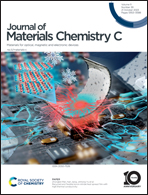Electron transfer-mediated triplet sensitization from CsPbI3 nanocrystals to fullerene for photon upconversion†
Abstract
Extracting excitonic energy from halide perovskite nanocrystals (NCs) with molecules has gained extensive attention due to its potential in photochemical and optoelectronics applications; however, the extraction methods and efficiency are highly dictated by the subtle interplay between NCs and molecules. Herein, we report that fullerene derivative C61(COOH)2 can extract the excitation energy of CsPbI3 NCs via electron transfer-mediated triplet energy transfer and then sensitizes perylene for photochemical upconversion. Spectroscopic investigation reveals that the electron of excited CsPbI3 NCs transfers to C61(COOH)2 upon excitation (∼2.2 ps), leading to the formation of a charge separation state between the NCs and C61(COOH)2, followed by a subsequent hole transfer (∼393 ps) from the NCs+˙ to the fullerene radical anion giving the population of triplet fullerene. In contrast, aromatic molecules hardly extract the energy of CsPbI3 NCs in the weak confinement regime through direct Dexter-type triplet energy transfer. This study establishes fullerene as an efficient relay to extract the excitonic energy of perovskite NCs in the form of molecular triplets.



 Please wait while we load your content...
Please wait while we load your content...